Drawing Interest
Not Just Another Pretty Face
by R.C. Harvey
NCS Member since 1985
Why am I a cartoonist? Did I start drawing seriously before I was a teenager? Was I encouraged to draw by parents, teachers? Did I develop my art abilities in school?
That’s enough to start. And before we’re done, we’ll have more than enough. More than is good for you. Whoever said “less is more” never came by my place. If less is more, think about how much more more is? Onward.
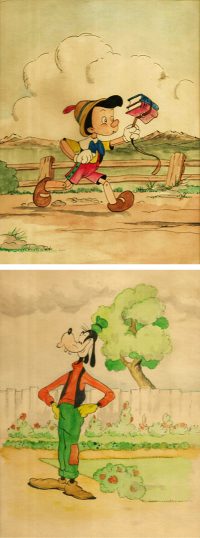 My father was an excellent artist. After he retired, he took up watercolor renderings of mountain scenery (he lived in Denver at the time). But, more to the point, when I was a youngster, he used to amuse me by copying my favorite cartoon characters on 8 ½ x 11-inch sheets, which he would then frame for me to hang on the walls of my room. I’m including a couple near here.
My father was an excellent artist. After he retired, he took up watercolor renderings of mountain scenery (he lived in Denver at the time). But, more to the point, when I was a youngster, he used to amuse me by copying my favorite cartoon characters on 8 ½ x 11-inch sheets, which he would then frame for me to hang on the walls of my room. I’m including a couple near here.
One evening when I was about seven, I was reading a comic book, and, excited by what I saw therein, I asked him to copy one of the characters that I liked. He was too busy at the moment, I guess, because he responded by saying: “Why don’t you draw it yourself?”
And so I did. And I kept on copying other people’s comic characters relentlessly for the next decade or so.
This was my “apprentice period.” Like artists of the Medieval times, I was copying the masters—albeit without their knowing it.
The more I drew, as you might expect, the better I got at it. Eventually, I stopped copying complete drawings and invented a few of my own, copying only parts of the techniques of cartoonists—the way this guy drew ears, the way the other guy drew hands, and so on. By the time I graduated from high school, all the piece-meal copying had evolved into what sympathetic observers might have called a “style” of my very own.
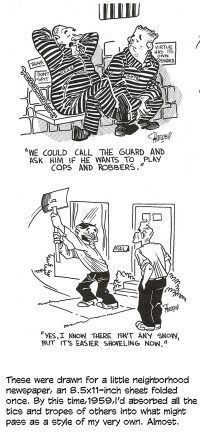 My parents encouraged me in this endeavor, although never in the excited ambitious manner of, say, the parents of a potential Olympic athlete. Friends of thefamily who learned I was drawing a lot, asked me what I wanted to be, and I’d say, “An artist.” It wasn’t until a few years later, that I learned the kind of “artist” I aspired to being was a “cartoonist,” and then when I answered family visitors’ questions, I would say, “A cartoonist.” And they would say, “Oh, you’re going to work for Disney?” And I would agree. But I never did.
My parents encouraged me in this endeavor, although never in the excited ambitious manner of, say, the parents of a potential Olympic athlete. Friends of thefamily who learned I was drawing a lot, asked me what I wanted to be, and I’d say, “An artist.” It wasn’t until a few years later, that I learned the kind of “artist” I aspired to being was a “cartoonist,” and then when I answered family visitors’ questions, I would say, “A cartoonist.” And they would say, “Oh, you’re going to work for Disney?” And I would agree. But I never did.
I lived in Edgewater, Colorado, a small town, and the schools there were small. My highschool graduating class had 22 people in it. At that dimension, the school couldn’t afford an art instructor. No art classes.
I remain, essentially, self-taught. Although I remember when I was in the first or second grade, I remember drawing a nurse in uniform, striding along. The teacher taught us begin a drawing with shapes—essentially, tubular shapes for arms and legs, big oval for the body, then put clothes on them. No stick-figure skeletons to start with; and to this day, I can’t draw stick figures as a way of roughing up a drawing. I use shapes. But that was about all the art instruction I ever had.
In high school, the typing teacher was sponsor of the school newspaper, and when I demonstrated some proficiency at typing, she made me editor of the paper. I learned about journalism from a little handbook she gave me. In college, I minored in journalism and worked on all the campus publications—daily newspaper, yearbook, magazines, the latter, a good outlet for cartooning. At first.
 By the time I was a teenager, I had learned that not all cartoonists worked for Disney. The most influential cartoonists I apprenticed myself to were Dick Sebald and Gus Arriola. Sebald produced a weekly black-and-white cartoon for the Denver Post’s Sunday magazine. Called Sage, Sand and Salt, it featured the comical adventures of a small-time rancher (he had only one cow) named Bailin’Wire Bill. I copied ol’ Bill for most of 1949 when I was twelve. I learned how to draw horses from Sebald. As far as I know, his strip didn’t appear any place except in the Denver Post. And it only lasted a year or so.
By the time I was a teenager, I had learned that not all cartoonists worked for Disney. The most influential cartoonists I apprenticed myself to were Dick Sebald and Gus Arriola. Sebald produced a weekly black-and-white cartoon for the Denver Post’s Sunday magazine. Called Sage, Sand and Salt, it featured the comical adventures of a small-time rancher (he had only one cow) named Bailin’Wire Bill. I copied ol’ Bill for most of 1949 when I was twelve. I learned how to draw horses from Sebald. As far as I know, his strip didn’t appear any place except in the Denver Post. And it only lasted a year or so.
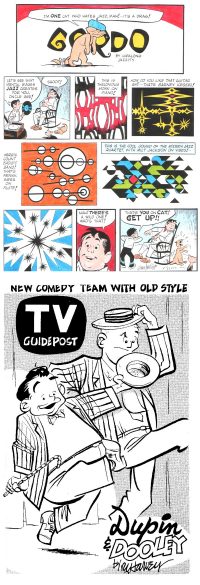 But by then, I’d discovered Arriola’s Gordo, also in the Denver Post—but 7 days a week. Arriola had just started modifying the way he drew, substituting a bold outline and simplified anatomy for what had been almost realistic rendering. For the first time in my apprenticeship, I didn’t copy the characters: instead, I tried to copy Arriola’s new drawing style. You might be able to discern my attempts in the accompanying drawing of two characters I invented my senior year in high school—Dupin and Dooley (the chubby one).
But by then, I’d discovered Arriola’s Gordo, also in the Denver Post—but 7 days a week. Arriola had just started modifying the way he drew, substituting a bold outline and simplified anatomy for what had been almost realistic rendering. For the first time in my apprenticeship, I didn’t copy the characters: instead, I tried to copy Arriola’s new drawing style. You might be able to discern my attempts in the accompanying drawing of two characters I invented my senior year in high school—Dupin and Dooley (the chubby one).
I worked up a comic strip presentation booklet, hoping to interest the campus newspaper in publishing Dupin and Dooley. They hadn’t the money for that sort of enterprise—making plates was too expensive, they said; but the editor said he was surprised that an entering freshman like me had captured the essence of college life.
At the University of Colorado in Boulder, I started drawing cartoons for the campus humor magazine as soon as I arrived on campus; the magazine was banned after two issues with my cartoons in them. They say there was no connection, but most of the magazine was my cartoons.
Freelancing—how did I do that, and how long did I submit cartoons before selling any.
I didn’t do any “commercial” cartooning in college—that is, I wasn’t doing any of it for money, more the fool me. But immediately upon graduation in 1959, I headed for New York to try freelancing magazine cartoons by taking them around to cartoon editors in person. I knew I would be drafted before long (in those antique times, the draft still existed), so I was simply taking a parting shot (so to speak) at marketing my cartoons.
With another CU grad, I found an apartment—on West 82nd, just a block from Riverside Drive with a subway stop at 79th. I worked four days a week: I tried to come up with gag ideas and suitable drawings on Thursdays, Fridays, Mondays and Tuesdays. Saturday and Sunday, I went sight seeing. Once I walked from 42nd Street to South Ferry, seeing things I was never able to find again—namely, a restaurant that had a Russell Patterson painting in the lobby. On Wednesday, I traipsed around town to magazine offices with a batch of 10-12 cartoons. Wednesday was called “look day”: editors held open house all day just to screen cartoon submissions, and in those days, lots of magazines that used cartoons had offices in New York City.
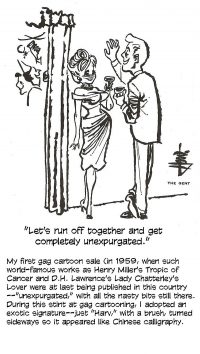 Because I knew that none of the editors had ever seen my work, I didn’t submit roughs, then the accepted practice (still is); I did finished art in order to show them what my final drawings looked like. After maybe a month of making the rounds, I finally sold one—to DuGent magazines. The cartoon editor, assuming my submission had been a rough, asked if my final drawing would look a lot like it. It would, I said. And he bought the so-called “rough.”
Because I knew that none of the editors had ever seen my work, I didn’t submit roughs, then the accepted practice (still is); I did finished art in order to show them what my final drawings looked like. After maybe a month of making the rounds, I finally sold one—to DuGent magazines. The cartoon editor, assuming my submission had been a rough, asked if my final drawing would look a lot like it. It would, I said. And he bought the so-called “rough.”
It was rumored that after making the rounds on Wednesdays, freelancing cartoonists would convene for lunch at the Palm or the Pen and Pencil. That’s what I’d heard. And they probably did, but although I undoubtedly sat across from more than one freelance cartoonist in the waiting room of an editor’s office, I was too shy to introduce myself. So I missed all the conviviality and drunken carrying on.
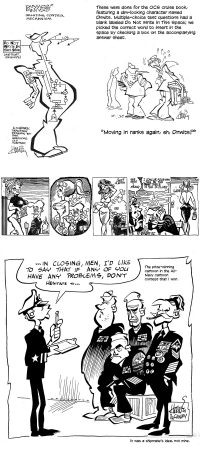 Years later, I was assured by one who was there that no drunken carrying on was carried on at these famed Wednesday lunches: everyone still had more editors to meet in the afternoon, and they preferred not to present their work while stewed.
Years later, I was assured by one who was there that no drunken carrying on was carried on at these famed Wednesday lunches: everyone still had more editors to meet in the afternoon, and they preferred not to present their work while stewed.
After a couple months in New York, I returned to Denver and Boulder to pick up some belongings I’d left behind. I spent a month selling some advertising cartoons in Boulder. Then I went to Kansas City to spend Christmas with my folks. By that time, I’d enlisted in the Navy as the only sure way to avoid the draft.
I went for officers’ training at Newport, Rhode Island, where I began my career as a Navy cartoonist, drawing cartoons for the “cruise book” (the yearbook). I then went to Supply Corps School in Athens, Georgia, became editor of the weekly base newspaper and drew a comic strip for it, starring Beau Sandy (his name was derived from BuSandA, the nautical shorthand for Bureau of Supplies and Accounts, for which we all worked).
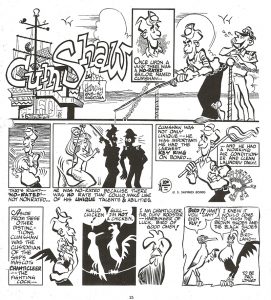 I spent the remaining three years of my enlistment aboard the aircraft carrier Saratoga, where I drew a comic strip for the ship’s monthly magazine. It was called Cumshaw after its protagonist; “cumshaw” is a Navy term that alludes to materials obtained in an unofficial manner (i.e., vaguely illegal, at least without paperwork). It’s also a verb: to cumshaw something is to obtain it without going through official channels. Perfect name for a sea-going con-man, which is what my hero was/is.
I spent the remaining three years of my enlistment aboard the aircraft carrier Saratoga, where I drew a comic strip for the ship’s monthly magazine. It was called Cumshaw after its protagonist; “cumshaw” is a Navy term that alludes to materials obtained in an unofficial manner (i.e., vaguely illegal, at least without paperwork). It’s also a verb: to cumshaw something is to obtain it without going through official channels. Perfect name for a sea-going con-man, which is what my hero was/is.
When I fled the Navy (it was only a fleeting thing, after all), I prepared presentation books for two comical adventure strips: Fiddlefoot and Heroes League.
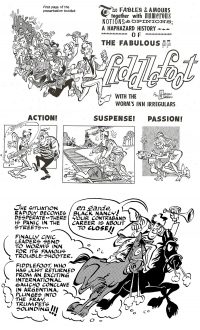 The presentation books consisted of pages displaying about 4-6 weeks of daily strips. For the first couple of weeks, I did finished art to prove I could draw. The rest of the strips were roughs, albeit fairly finished; they were to prove I could tell a story with a gag at the end of every installment. Both these strips were continuities at a time when continuity strips were swiftly dying out. Neither sold.
The presentation books consisted of pages displaying about 4-6 weeks of daily strips. For the first couple of weeks, I did finished art to prove I could draw. The rest of the strips were roughs, albeit fairly finished; they were to prove I could tell a story with a gag at the end of every installment. Both these strips were continuities at a time when continuity strips were swiftly dying out. Neither sold.
I worked up three other strips ideas (Remuda about a cowboy, Rundle about a con man, Hinshaw about a mailman), but none of them inspired me, so I gave up on each one in turn. Each was devised as a gag-a-day strip, and I didn’t feel comfortable without a story.
The first two strips I tried to sell while I was in New York during the summer, taking courses towards a master’s degree. I took the presentation books around to syndicate offices, dropping them off one week and returning the next to get the verdict.
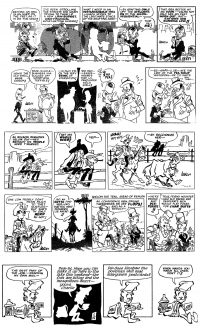 The visit to King Features was memorable. I was sent up the elevator to the fifth floor. There, I was met in the elevator alcove by someone I assumed to be an editor (but not The Cartoon Editor; just some bullpen flunky). He looked at my presentation books, said they looked fine, but that King was not buying any strips at the time.
The visit to King Features was memorable. I was sent up the elevator to the fifth floor. There, I was met in the elevator alcove by someone I assumed to be an editor (but not The Cartoon Editor; just some bullpen flunky). He looked at my presentation books, said they looked fine, but that King was not buying any strips at the time.
“It’s like this,” he explained, “we have so many strips out there in newspapers, that if we come in to an editor and sell a new one, chances are, the paper will drop another King strip to make room for it.”
This probably made sense at the time. Now, I wonder why a newspaper couldn’t just keep adding good, new strips to its lineup as long as good, new strips showed up. Why the arbitrarily imposed limit? But then, I never pretended to understand editors even though I’d been one several times in college.
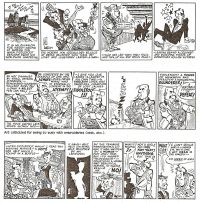 Fiddlefoot was my fondest creation. He had been lurking in my head all during my Navy career. I doodled him constantly. His adventures shadowed me wherever I went. I loved him. When he didn’t sell, some of the steam went out of my desire to be a comic strip cartoonist. Besides, I had to make a living, and I turned to teaching in high school.
Fiddlefoot was my fondest creation. He had been lurking in my head all during my Navy career. I doodled him constantly. His adventures shadowed me wherever I went. I loved him. When he didn’t sell, some of the steam went out of my desire to be a comic strip cartoonist. Besides, I had to make a living, and I turned to teaching in high school.
But after earning a Ph.D., I returned to cartooning—freelancing magazine gag cartoons. This time, I did it all through the mail, in my spare time.
Because thinking up gags was harder work than drawing pictures, I let gag writers do the hard labor. Can’t remember how I acquired their names and addresses (probably from one of the trade journals at the time—maybe Gag Recap), but I eventually had a half-dozen or so. They’d send me jokes on slips of paper, and I’d keep the ones I liked. When one sold, I sent the gag writer 15% of the take. Later, I upped their percentage to 25%, hoping I’d get better gags—first choice in a lineup.
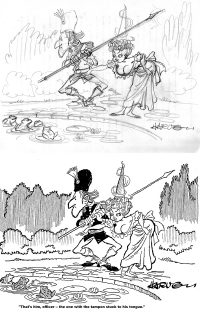 I’d work up roughs during my lunch hour at work (I was fully employed then as a convention manager). That weekend, I’d produced the final art, which I did in what I still suspect is a unique manner.
I’d work up roughs during my lunch hour at work (I was fully employed then as a convention manager). That weekend, I’d produced the final art, which I did in what I still suspect is a unique manner.
Laying a piece of tracing paper over a rough pencil sketch, I used a pencil again, this time tracing the final lines onto the tracing paper. I “scrubbed” the lines, producing a ragged-edge line. Then I photocopied this pencil version, inking it instantly. I’d later add shading and solid blacks.
This procedure was prompted by rumors that I’d heard about some magazine editors “losing” (or keeping) cartoons. Or spilling coffee on them. Or otherwise rendering the work I’d submit unusable. If any such thing happened to my cartoons, I’d pull out the pencil tracing and produce new final inked versions nearly instantly. The rumors were probably wrong: I never had occasion to resort to this maneuver. Once, in fact, an editor wanted the original of an illustration I’d done for an article in his magazine, and he asked me how much he should pay for it.
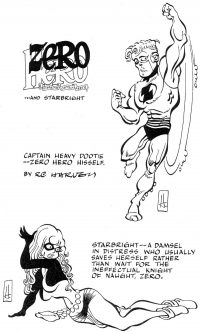 To this day, I produce most of my cartoons (not many: I prefer writing to drawing) the same way, inking by photocopying. Now, however, I’ve abandoned the raggedy line. I trace the rough using a fine-line gel pen. Then when I get the photocopy, I fatten up the lines wherever I think a bolder line is needed. If I make a mistake, I’ve got another photocopy at hand to use; I discard the ruined photocopy and use a fresh one.
To this day, I produce most of my cartoons (not many: I prefer writing to drawing) the same way, inking by photocopying. Now, however, I’ve abandoned the raggedy line. I trace the rough using a fine-line gel pen. Then when I get the photocopy, I fatten up the lines wherever I think a bolder line is needed. If I make a mistake, I’ve got another photocopy at hand to use; I discard the ruined photocopy and use a fresh one.
After I had about 20 cartoons, I’d package them up and send them off to magazine cartoon editors. The package contained the cartoons and a stamped return envelop. The first mailing for a new batch went to the highest paying magazine on my list; the second mailing to the next highest paying, and so on down a list of steadily diminishing pay rates. I kept a log book, showing where each batch had been—and which cartoons had been sold. Every cartoon carried a different code.
 At first, I did a batch of “general interest” cartoons and sent them off to magazines of “general interest,” starting with the National Enquirer, then the second top-paying general interest publication; The New Yorker was first (and still is). Then I did a batch for men’s magazines, tailoring the ’toons for that interest—plenty of barenekkidwimmin, in other words. The cartoons that went to men’s magazines sold better than the general interest cartoons. Obeying the unwritten rules of the market, I started producing more batches for men’s magazines than for general interest magazines. I became a “girlie cartoonist.”
At first, I did a batch of “general interest” cartoons and sent them off to magazines of “general interest,” starting with the National Enquirer, then the second top-paying general interest publication; The New Yorker was first (and still is). Then I did a batch for men’s magazines, tailoring the ’toons for that interest—plenty of barenekkidwimmin, in other words. The cartoons that went to men’s magazines sold better than the general interest cartoons. Obeying the unwritten rules of the market, I started producing more batches for men’s magazines than for general interest magazines. I became a “girlie cartoonist.”
With the girlies, I did pretty well, as I recall. I sold maybe 50% of a batch by the time it had made the rounds. The last ones sold were being gobbled up at $5 each at a magazine published in Texas called Sex to Sexty. I tried selling to the top markets— The New Yorker, Playboy, Penthouse, Hustler, etc. I sold one eventually to Penthouse, but I didn’t crack any of the other top markets.
 I did best at DuGent, which published Dude, Gent, and a couple others. They paid about $25 at the time. My last year freelancing, I was doing a comic strip for one of their magazines. Entitled Leda’s Ugly Duck, it featured a swan and a naked wood nymph named Leda, all inspired by Greek mythology (if you can believe that): Zeus had an affair with Leda which he conducted in the form of a swan. It was a good gig. I’d rough out a story and send the rough off to the editor. He’d approve it (never made any changes that I can recall), and then I’d do the final art—again, inking by photocopying (doing a couple panels of the strip at a time and then pasting them up in page format). It started as a one-page feature and graduated to four pages.
I did best at DuGent, which published Dude, Gent, and a couple others. They paid about $25 at the time. My last year freelancing, I was doing a comic strip for one of their magazines. Entitled Leda’s Ugly Duck, it featured a swan and a naked wood nymph named Leda, all inspired by Greek mythology (if you can believe that): Zeus had an affair with Leda which he conducted in the form of a swan. It was a good gig. I’d rough out a story and send the rough off to the editor. He’d approve it (never made any changes that I can recall), and then I’d do the final art—again, inking by photocopying (doing a couple panels of the strip at a time and then pasting them up in page format). It started as a one-page feature and graduated to four pages.
In short, doing the strip was a “sure sale.” And while I was doing it, I did no other new batches of single panel cartoons. I was making more on the strip every month ($300 as I recall) than I’d ever made in a month by selling gag cartoons “on spec” (speculation). Then the bottom dropped out of my little cartooning universe: DuGent stopped publishing the magazine that my strip was running in. And the strip wasn’t considered suitable for any of the other DuGent magazines.
By then, I was spoiled: I’d become accustomed to my “sure sale” comic strip and didn’t want to return to the “spec” scheme.
And I’d started writing about cartooning for fan magazines like The Comics Journal and the old and revered Rockets Blast Comic Collector (RBCC). I enjoyed writing more than drawing, so I gave up on the latter. Journalism won out over cartooning.
Some say I’m a comics “historian.” But I prefer “chronicler” instead of “historian” because I deal in contemporary comics as well as historical ones. My online magazine, Rants & Raves (at RCHarvey.com), does comics news and reviews, cartooning history and lore, at the rate of once or twice a month. Been going now for over 18 years.
I remembered when closing in on the end of the 18th year that when I graduated from Colorado University, I’d dreamed of editing and publishing a humor magazine. And now, oddly—after 58 years spent dabbling at other endeavors—I’m doing almost just that, albeit online and with very little revenue. And it’s not a humor magazine, but it permits me to talk endlessly about cartooning. Which, as you by now realize, I can, indeed, do endlessly.
Now back to the questions you sent me.
How many books have I written on cartooning and cartoonists?
Thirteen. I’ve written nine and edited another four. Most of them are described and sold at my website, RCHarvey.com. A few are not; I’ll describe them here. I edited three volumes of Cartoons of the Roaring Twenties; two were published by Fantagraphics before they discovered how poorly the first two volumes were selling and stopped before doing the third; it will doubtless never see print. I don’t carry these at my website.
Two of my books are now out-of-print. I did a biography of comic book artist Murphy Anderson, published by TwoMorrows. I say I “edited” it. Its genesis is unusual, I think. I interviewed Murphy over the phone several times, but when he said he didn’t want the Comics Journal to publish it, I was stuck: the Comics Journal was my major outlet.
Then TwoMorrows popped up and wondered if I could do a book on Murphy. I had all this taped interview material, so I said, Yes. Then I had all the interviews transcribed and went through them, removing all the questions and leaving only Murphy’s answers. I arranged the answers in chronological order and—presto: a biography that was autobiographical was done.
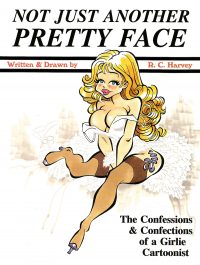 The other out-of-print book is Not Just Another Pretty Face: The Confessions and Confections of a Girlie Cartoonist. Mostly, this one collects my cartoons about barenekkidwimmin and accompanies the pictures with some essays of explication. Lost Art Books, the flagship series from Picture This Press, is planning to publish an expanded version of this title in September 2017. I had fun designing the cover to look like the old Saturday Evening Post covers, coupling a strait-laced momento to a salacious picture.
The other out-of-print book is Not Just Another Pretty Face: The Confessions and Confections of a Girlie Cartoonist. Mostly, this one collects my cartoons about barenekkidwimmin and accompanies the pictures with some essays of explication. Lost Art Books, the flagship series from Picture This Press, is planning to publish an expanded version of this title in September 2017. I had fun designing the cover to look like the old Saturday Evening Post covers, coupling a strait-laced momento to a salacious picture.
Who is the most interesting cartoonist I ever met? The funniest in person? The quietest?
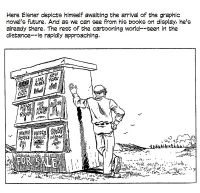 Will Eisner is probably the most interesting—chiefly because his career is so varied. He started in comic books (effectively inventing aspects of the form), continued with instructional comics (which he virtually invented), and finished by promoting and developing the graphic novel form. Perhaps the greatest of cartooning’s pioneering masters, he remained engaged and interested throughout his career, always looking for new ways to apply his cartooning skills and knowledge.
Will Eisner is probably the most interesting—chiefly because his career is so varied. He started in comic books (effectively inventing aspects of the form), continued with instructional comics (which he virtually invented), and finished by promoting and developing the graphic novel form. Perhaps the greatest of cartooning’s pioneering masters, he remained engaged and interested throughout his career, always looking for new ways to apply his cartooning skills and knowledge.
Years ago, I substituted for Eisner at some sort of cartoon conference at a midwestern college: he was scheduled to appear but got sick at the last minute and couldn’t make it, so I did a presentation about Eisner’s cartooning life and career.
Playboy/New Yorker cartoonist Eldon Dedini was fascinating. He was an artist’s cartoonist: the picture interested him more than the caption. He regularly clipped pictures he liked from a host of magazines he subscribed to. He pasted the pictures into scrapbooks, sometimes adding his visual interpretation to the page and jotting gag ideas next to the pictures/drawings. And when looking for inspiration for a cartoon for Playboy or The New Yorker, he would browse through the scrapbooks.
 Sometimes he’d draw the picture for a cartoon—in full color, destined for Playboy—and then put it into a frame and prop it up in his study or his bedroom, waiting for it to “tell him” the caption.
Sometimes he’d draw the picture for a cartoon—in full color, destined for Playboy—and then put it into a frame and prop it up in his study or his bedroom, waiting for it to “tell him” the caption.
Milton Caniff was also highly interesting. When he invited me to do his biography, it enabled me to talk with him about every aspect of his career—something I would never have had the nerve to do otherwise—and his career spanned the history of the newspaper adventure comic strip, from beginning to end.
And Gus Arriola was a dream come true. I’d imitated his drawing style when I was a teenager, and to meet this master and get acquainted with him on a friendly basis was all I could have hoped for.
None of these guys were particularly funny. And I can’t remember any cartoonist I’ve met who was funny in person. On paper, yes; but not in person. Cartoon comedy is different than stand-up.
What the heck is going on in cartooning today? Is the Internet good for cartooning? Or is it cheapening the art form? Do we have any choice about using it or not?
The Internet is clearly one of the futures of cartooning. But since there are no gatekeepers (like feature syndicates or cartoon editors), the quality of the work is iffy. Some excellent stuff is being done. Sinfest, a daily strip by Tatsuya Ishida, has been regaling us with its quirky humor since January 2000. And there are a few others. Mostly, however, web comics are pretty sad graphically speaking, and the humor evades me more often than not. (More my problem than theirs, no doubt.) Still, the web is a good place to train, and it’s lively in that apprentice function.
Magazine cartooning has been fading ever since the collapse of the Saturday Evening Post as a weekly publication in 1963. Other great venues for gag cartooning—Collier’s, Look, Saturday Review, etc.—joined the SEP at about the same time, late 1950s–1960s. And when Playboy stopped publishing cartoons in March 2016, that left only The New Yorker as a major market for gag cartooning. Other markets exist (consult Gag Recap website to get a start at a list), but the pay is so low I doubt anyone can make a living cartooning for magazines.
The liveliest place for good cartooning these days is comic books. And it’s not just superhero antics by overwrought anatomies in tighty whities. All sorts of adventuring and joking is going on, and new titles on different life styles pop up every month; some don’t last long, but other new endeavors take their places quickly. The gratifying growth of the graphic novel has further stimulated the medium in both art and story.
The fate of newspaper comic strips is tied to the fate of newspapers, and while the prospects don’t seem, offhand, very encouraging, the situation is better than it seems. I inveigh against the fake death of newspapers elsewhere on this site, so I won’t repeat myself here. But there are a couple more things I can add to that.
First, new comic strips continue to be created. Not as many as in the fond days of yesteryear, but new strips signal that there is some life left in the medium.
Second, newspaper circulation, which has been declining alarmingly since the advent of the Web, is reviving and doing better than supposed.
Oddly, the election of the Trumpet has resulted in a surge of newspaper subscriptions. In the week after the election, the New York Times netted 41,000 new subscribers, according to a Huffington Post report; in the two days after Election Day, the Times website got record traffic, and readers spent five times longer on the site than they normally did. The Wall Street Journal had similar experience: the day after Election Day, new subscribers spiked with a 300% increase. By the end of the month, the Times had 132,000 more subscriptions in its print and digital editions. And the Washington Post reported that it experienced a steady increase in subscriptions through 2016; ditto the Los Angeles Times.
At the end of last year, the Washington Post expected to hire more than 60 journalists this year. Amazon’s Jeff Bezos bought the Post in October 2013 and invested $50 million in the company last year—an investment, it turns out, that’s paid off. At npr.com, Post’s publisher Fred Ryan said that the paper is now “a profitable and growing company.” He said the Post’s online traffic has increased by nearly 50 percent in 2016 and new subscriptions have grown by 75 percent, more than doubling digital subscription revenue.
By the end of 2016, the New York Times had added 276,000 new paid digital subscriptions, and digital advertising revenue rose almost 11% to $77.6 million in 2016’s last quarter.
The phenomenon seems to be a direct result of the Trumpet’s casual regard for facts. People subscribe to newspapers in print and digital in order to find out what’s really going on—rather than believe, as an article of faith, whatever the Trumpet says.
Termed “the Trump bump,” the increase has enabled the New York Times to pass the 3 million subscriptions threshold in the first three months of 2017. By the end of March, saith thestreet.com, the Times will have “added 500,000 new net subscribers over a six-month period, unprecedented in U.S. history.” The Washington Post is seeing “double digital subscription revenue in the last 12 months, with a 75% increase in new subscribers.” Other large regional papers report similar growth.
And magazines are doing well, too. The New Yorker sold 250,000 new subscriptions between Election Day and the end of January 2017, “up 230% compared with the same three-month period a year ago. … The magazine now has its largest circulation ever, at more than a million.”
The reported increases include paid subscriptions to both the publications’ Internet editions and to the print versions. Clearly, the daily newspaper is not in its death throes just yet. And if newspapers are doing well, so will comic strips.
Advertising revenue is still the chief financial support of newspapers. Subscriptions never produced enough revenue to do more than pay for printing. With the surge in subscriptions, newspapers become more viable as advertising vehicles: more people see the ads. But there’s more good news buried in this phenomenon.
As subscriptions increase, newspapers become more dependent upon subscriptions—that is, readers. Advertising is still important, but readership assumes a new importance, and with that, newspapers must necessarily pay attention to what readers want. And readers want comic strips.
Readership surveys consistently show that comics rank among the top four in popularity—front page, sports, obits and/or comics. So if newspapers wish to maintain and/or increase subscriptions/readers, they’ll attend to the things readers enjoy most. Comics.
This line of reasoning is fraught with fallacious logic, no doubt; but I like the conclusion, so I’m sticking with it.
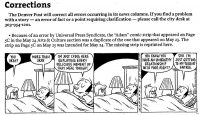 Newspapers know the value of the comics to their bottom lines. They’ve always known. And that knowledge has not faded. Recently, my hometown paper, the Denver Post, provided a vivid demonstration of this prevailing wisdom. Through some syndicate snafu, one of the installments of Adam @Home was missing for the intended publication date, and the Post published the missing strip as soon as it became available—on page 2 of the paper, not on the comics page. And the Post explained why the strip appeared there. If that doesn’t indicate a surviving priority, nothing does. Why make a big fuss over the event if editors don’t know comics are important to readers?
Newspapers know the value of the comics to their bottom lines. They’ve always known. And that knowledge has not faded. Recently, my hometown paper, the Denver Post, provided a vivid demonstration of this prevailing wisdom. Through some syndicate snafu, one of the installments of Adam @Home was missing for the intended publication date, and the Post published the missing strip as soon as it became available—on page 2 of the paper, not on the comics page. And the Post explained why the strip appeared there. If that doesn’t indicate a surviving priority, nothing does. Why make a big fuss over the event if editors don’t know comics are important to readers?
When did I become a member of NCS?
I think it was in the early 1980s. In those days, one had to be recommended for membership by two members. And you had to be a published cartoonist. I was still freelancing magazine gag cartoons at the time, so I met that criteria. I was working with Milton Caniff on his biography, so I asked him if he’d recommend me, and he did. Because he was so important in the history of NCS, I suspect his recommendation alone was enough. I also got Shel Dorf to put my name in. Since I was not actually making a living by cartooning, I qualified only for associate membership. A few years later, I dropped out when a dues differential was introduced that made associate members pay more. After I passed retirement age, however, I was able to renew my membership at the “senior” rate, a much happier situation. And my current membership has been operative since the early 2000s.
Geez. Did I really write all of this in response to a dozen questions? Well, yes, obviously. But that’s what writers do: they write, relentlessly, endlessly.
Thanks for asking.
